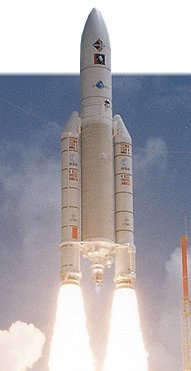Thu, Jan 09, 2003
Newest -5 Design Iteration Affected; Base Design OK
 There may have been cracks in
the cooling circuits of the hot-rodded Ariane-5 that blew up last month; and those cracks,
while critical, aren't something that's likely to really foul up
the entire European launch system.
There may have been cracks in
the cooling circuits of the hot-rodded Ariane-5 that blew up last month; and those cracks,
while critical, aren't something that's likely to really foul up
the entire European launch system.
The formal Inquiry Board, set up after the failed December
launch attempt, concluded that, "...the most probable cause of the
failure of Flight 157 was the simultaneous occurrence of two
aggravating factors:
- The degraded thermal condition of the nozzle due to fissures in
the cooling tubes, and
- Non-exhaustive definition of the loads to which the Vulcain 2
engine is subjected during flight
 The board also noted that it would
be difficult to simulate these additional loads during ground
tests.
The board also noted that it would
be difficult to simulate these additional loads during ground
tests.
The newest-version Ariane-5 certainly needs attention,
though.
On Wednesday, Arianespace boss Jean-Yves LeGall told the AP, "I
consider that the generic Ariane-5 has been cleared by the
commission’s work. We have no worries about the basic
Ariane-5 launcher." Apparently, not all the rocket's engines
failed; the asymmetric thrust, as well as the overall loss of
power, doomed December's launch.
That kind of good news/bad news statement needs to be put into
perspective. The Vulcain-2 engine is what makes the latest -5 such
a workhorse: it can send 10 tons of expensive stuff into orbit, as
opposed to the Vulcain-1's 7-ton limit.
The Vulcain-2 is slated to launch three times in 2003; repairs
and modifications are expected to take six months. LeGall says the
Vulcain-1-powered rockets will handle this year's launches, if
necessary -- the heavier payloads aren't scheduled for at least a
year.
The smaller Ariane-4 rockets continue to be launched and might
shoulder some of the short-term launch load, even though their
production has already stopped. The next Ariane-4 launch is set for
February 11.
More News
Also: Netherlands Donates 18 F16s, 2 737s Collide On Ramp, E-7 Wedgetail Cut, AgEagle's 100th In S Korea The Pilot and Aircraft Privacy Act was introduced in the House by Represent>[...]
Pilot Also Reported That Due To A Fuel Leak, The Auxiliary Fuel Tanks Were Not Used On June 4, 2025, at 13:41 eastern daylight time, a Piper PA-23, N2109P, was substantially damage>[...]
Have A Story That NEEDS To Be Featured On Aero-News? Here’s How To Submit A Story To Our Team Some of the greatest new stories ANN has ever covered have been submitted by our>[...]
From 2023 (YouTube Edition): Reflections on War’s Collective Lessons and Cyclical Nature The exigencies of war ought be colorblind. Inane social-constructs the likes of racis>[...]
What Goes Around, May Yet Come Back Around, Klyde FMI: www.klydemorris.com>[...]
 Airborne 06.30.25: US v ADS-B Misuse, Natl STOL Fire, Volocopter Resumes
Airborne 06.30.25: US v ADS-B Misuse, Natl STOL Fire, Volocopter Resumes NTSB Prelim: Piper PA-23
NTSB Prelim: Piper PA-23 ANN FAQ: Submit a News Story!
ANN FAQ: Submit a News Story! Classic Aero-TV: One Mans Vietnam
Classic Aero-TV: One Mans Vietnam Klyde Morris (06.30.25)
Klyde Morris (06.30.25)




